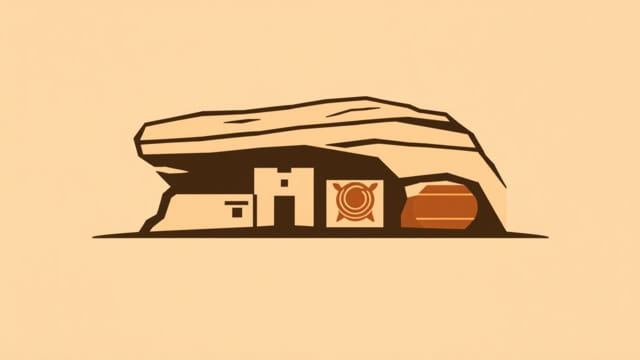Unique Facts About The Anasazi
The Anasazi, also known as the Ancestral Puebloans, were a remarkable Native American civilization that flourished in the southwestern region of what is now the United States. Living in areas like present-day Arizona, New Mexico, Colorado, and Utah, the Anasazi people developed complex societies, impressive architectural feats, and unique cultural practices that continue to intrigue historians and archaeologists. Their legacy, visible in ancient cliff dwellings and petroglyphs, paints a vivid picture of a people deeply connected to their environment, spirituality, and community. Exploring unique facts about the Anasazi reveals the depth of their innovation and cultural significance.
Origins and Cultural Identity
Early Settlements and Agricultural Innovation
The Anasazi emerged around 100 CE, evolving from earlier groups of hunter-gatherers. One of their most notable accomplishments was the transition to a sedentary lifestyle supported by advanced agricultural practices. They cultivated crops such as corn, beans, and squash using sophisticated irrigation systems that diverted and conserved scarce water in the arid Southwest. This innovation allowed their communities to grow and sustain themselves in a challenging environment.
Name and Meaning
The term Anasazi is derived from the Navajo language, meaning Ancient Enemies or Ancient Ones, which some descendants find controversial. Today, the preferred term is Ancestral Puebloans, recognizing their direct link to modern Pueblo peoples such as the Hopi and Zuni tribes. This shift highlights a growing respect for indigenous perspectives and cultural continuity.
Architectural Marvels
Cliff Dwellings
Among the most striking features of Anasazi culture are their cliff dwellings. Built into the sides of canyons and cliffs, these structures served both practical and defensive purposes. The most famous example is Cliff Palace in Mesa Verde, Colorado, which includes over 150 rooms and multiple kivas, or ceremonial chambers. The use of sandstone, wooden beams, and mortar in multi-story buildings demonstrates their engineering skill.
Pit Houses to Great Houses
The Anasazi began with pit houses dug into the ground and eventually progressed to above-ground pueblos and massive Great Houses such as those found in Chaco Canyon. These structures functioned as hubs for trade, ceremonies, and administration. The layout of these buildings suggests advanced planning and communal labor, as well as a deep understanding of astronomy and seasonal cycles.
Astronomical and Spiritual Knowledge
Solar and Lunar Alignment
One of the lesser-known facts about the Anasazi is their keen observation of celestial bodies. Many structures align with solar and lunar events. The Sun Dagger site on Fajada Butte in Chaco Canyon is a famous example, where light patterns mark solstices and equinoxes. This evidence suggests the Anasazi integrated astronomical knowledge into religious and agricultural practices.
Kivas and Ceremonial Practices
Kivas were circular, subterranean rooms used for spiritual ceremonies, often located in the center of Anasazi settlements. These spaces symbolize the connection between the spiritual and earthly realms, and their design reflects cosmological beliefs. Features like the sipapu, a small hole in the kiva floor, represent the emergence of ancestors from the underworld a key element of Puebloan mythology.
Social and Trade Networks
Extensive Trade Routes
The Anasazi were far from isolated. Archaeological findings reveal trade connections stretching as far as Mesoamerica and the Pacific Coast. Items such as macaw feathers, copper bells, turquoise, and seashells have been discovered in Anasazi sites, indicating long-distance exchange. These networks not only spread goods but also ideas, rituals, and technologies.
Complex Social Organization
Evidence points to a highly organized society with distinct roles, likely including religious leaders, artisans, and farmers. The construction of monumental buildings and coordination of agricultural calendars implies a system of leadership and communal cooperation. Artifacts such as pottery and woven textiles reveal a society rich in artistic expression and craftsmanship.
Mysterious Disappearance and Legacy
Environmental and Social Factors
By the late 1200s, many major Anasazi settlements were abandoned. Scholars believe a combination of prolonged drought, resource depletion, and social upheaval led to this migration. Rather than disappearing, the Anasazi people are believed to have integrated with other communities and evolved into present-day Pueblo cultures.
Continuing Cultural Presence
Modern descendants of the Anasazi, such as the Hopi, Zuni, and Rio Grande Pueblo peoples, continue to maintain traditions rooted in their ancestral heritage. Oral histories, ceremonies, and agricultural practices have been preserved and passed down through generations. These living cultures serve as a bridge to understanding the past while affirming indigenous resilience and identity.
Unusual and Lesser-Known Facts
- Stone Towers and Road Systems: The Anasazi built over 400 miles of straight roads, possibly used for ceremonial processions rather than trade. These roads, some as wide as 30 feet, reflect a symbolic as well as practical purpose.
- Distinct Pottery Styles: Anasazi pottery evolved into highly decorated black-on-white ceramics, which help archaeologists trace cultural changes and timelines.
- Fingerprints in Plaster: Builders often left fingerprints in the plaster walls of their homes, a subtle human trace that connects us directly with individuals from the distant past.
- Petroglyphs and Rock Art: The Anasazi left thousands of petroglyphs and pictographs etched or painted onto rocks, depicting animals, spirals, human figures, and abstract designs.
- Bone Tools and Jewelry: Aside from stone tools, they also crafted items from bones and shells, including pendants and hair ornaments that indicate personal adornment and status.
The Anasazi civilization remains one of the most intriguing and influential cultures of ancient North America. Their accomplishments in architecture, agriculture, astronomy, and societal organization speak to a highly advanced and adaptive people. Far from being lost to time, the spirit of the Anasazi endures in the living traditions of modern Pueblo communities. As research continues and new discoveries are made, our appreciation for their legacy only deepens. Understanding the unique facts about the Anasazi not only honors their memory but also enriches our knowledge of human resilience and ingenuity.
